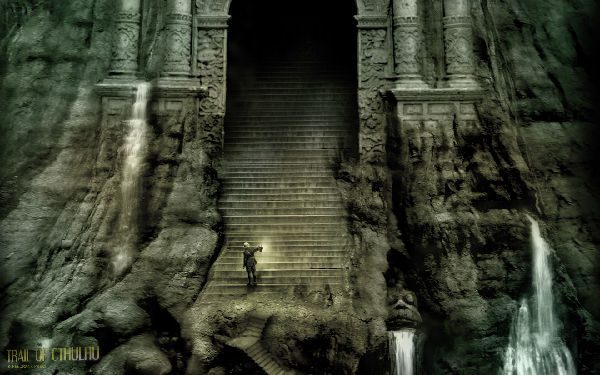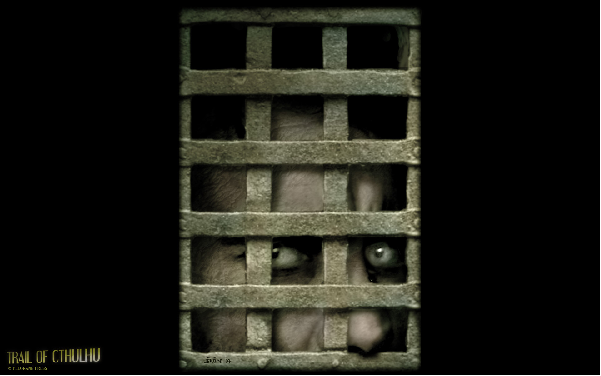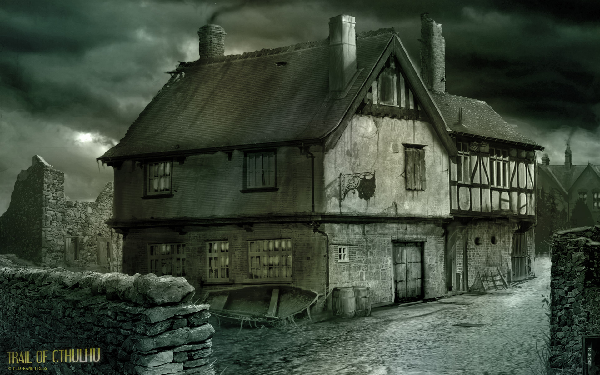Twitterific co-creator Craig Hockenberry tells how and when a bird became synonymous with Twitter, and reveals the secret history of “tweet” as a noun and verb for Twitter messages and the act of publishing them.
Twitterific co-creator Craig Hockenberry tells how and when a bird became synonymous with Twitter, and reveals the secret history of “tweet” as a noun and verb for Twitter messages and the act of publishing them.
This post is part of the H. P. Lovefest. TL;DR: I have rapidly become a fan of the Trail of Cthulhu roleplaying game, a modern, player-facing alternative to Call of Cthulhu that highlights the investigative aspect of Lovecraftian adventuring.
I’ve always loved all kinds of games, but the frequency at which I played RPGs was, until recently, about once a decade: a handful of D&D sessions as a kid, an afternoon of Top Secret in high school, a GURPS session in college, and a taste of Call of Cthulhu in my early 30s. Of the many systems I’ve learned (and the number I’ve learned is an order of magnitude greater than the number I’ve played, alas), Call of Cthulhu (CoC) was by far my favorite. Not only am I a sucker for the horror genre in general, and H. P. Lovecraft in particular, but I also appreciated the game for putting the narrative front in center, with the dice relegated to a supporting role.
A few years ago I picked up a copy of Trail of Cthulhu (ToC), knowing full well that, like dozens of other RPGs I have purchased over the years, it would be read but likely never played. But the system appealed to me to such a degree that I decided to actually try it out. And so, on Halloween of 2011, I gathered several of my friends and subjected them to the eldritch horrors that the game has to offer. The evening was so successful that I have run the game several times since, for a variety of friends and acquaintances. It’s with thanks to ToC that I can, at long last, add the title of “roleplayer” to my gaming resume without resorting to exaggeration or wishful thinking.

Even the cover of Trail of Cthulhu emphasizes the investigative nature of the game
GUMSHOE
Why did I enter the world of roleplaying with Trail of Cthulhu, rather than in the company of its much lauded forefather? Because ToC emphasizes the investigative aspect of the game, which I find to be the most fun. In fact GUMSHOE, the engine thrumming within ToC, is specifically tailored for mystery-oriented RPGs, and the exploration of Lovecraft’s horrors is but one of its many application.
GUMSHOE is built around a simple proposition, albeit one viewed as heretical by many Call of Cthulhu fans: characters in an investigative game should be given the clues for free. In other words, players need not “Spot Hidden” to find the essential manuscript, pass a “Listen” check to hear the scratching behind a secret door, or miss out on a key piece of information because they failed to interrogate a wino four scenes back. If an Investigator is in a location containing a clue, and has a skill appropriate for finding it, the Keeper forks it over. No dice rolls, no chance of failure, no games derailed for want of a well-hidden journal.
GUMSHOE accomplishes this by dividing an Investigators skills into two broad classes: Investigative and General. Investigative Abilities, such as Occult and Flattery are those that enable players to learn things, and work automatically. If a character in the story has information and is susceptible to flattery, for instance, a player need only declare that they are laying on the charm to get the goods. General Abilities Abilities, like Firearms and Fleeing, on the other hand, are those that enable players to do things. Unlike Investigative Abilities, General Abilities require a dice roll, and can result in failure. So while finding the combination to the safe is a given, sneaking past a rogue shoggoth is not without risk.
Some Call of Cthulhu players find this to be even more blasphemous than the creatures they routinely face. Finding clues is the entire point of a mystery , they argue, and removing that element neuters the game. The creators of GUMSHOE beg to differ, and cite as evidence for their position the traditional police procedural, where the finding of the clues is a given, be it Sherlock Holmes spotting mud on a suspect’s shoe or the CSI team sweeping a motel room for DNA. The interesting part of the story, they posit, is in the interpretation and synthesis of the of clues, as the detectives move from scene to scene scene, drawing ever closer to their quarry. GUMSHOE works by deprecating the drudgery of evidence collection and highlighting the fun of piecing together the Horrible Truth.

What could go wrong?
On the Trail
With Trail of Cthulhu, Kenneth Hite Hite’s takes the GUMSHOE system and plunks it into the world of H. P. Lovecraft. Hite has an impressive resume in both RPG creation roleplaying design (he is credited with GURPS Horror) and the Mythos (on which he has written several books), and his considerable experience is obvious in the design. he brings his experience to bear on the project.
The first 80 pages of the book sourcebook are essentially Hite’s conversion of Call of Cthulhu to the GUMSHOE system. Yes ToC is its own game, but there is no way (nor need) to deny CoC’s omnipresent influence. PCs are called “Investigators” and the GM is the “Keeper”; many of CoC’s signature skills (e.g., Credit Rating and Psychoanalysis) have been carried over; and yes, characters have a Sanity rating, which will erode over the course of several games.
Hite augments all this with a number of innovations. Stability, for instance, is a measure of an Investigator’s short-term mental well-being, and can be refreshed by completing adventures, finding safe haven, via the application of Psychoanalysis, and so forth. (As in CoC, however, Sanity tends to be a one-way street toward madness.) Investigators also have built in motivators, including Drives (Curiosity, Ennui, and other explanations as to why they investigate the Mythos) and Pillars of Sanity (core beliefs, such as “Science trumps superstition”).
The latter two-thirds of the Trail of Cthulhu book contains a wealth of material, from an overview of the 1930′s (the default era for ToC adventures), tips for Keepers, an Introductory adventure, and a repository of campaign ideas. Of particular note is the chapter on the Mythos, where Hite provides detailed descriptions of the creatures, tomes, spells, and entities that inhabit the Lovecraftian universe. He even provides multiple possibilities for each of the Great Old Ones, allowing Keepers to choose the form of the Destructor they wish to unleash on their hapless players. Here, for instance, are three of Hite’s six interpretations of Ithaqua:
- The Great Old One Ithaqua, the Wind-Walker, dwells in the Arctic wastes. It abducts lone travelers or those who have attracted its unfavorable attention, carrying them off into the auroral skies. They are found weeks or months later, frozen solid in positions of great agony, missing random body parts, and partly buried in the ground as if dropped from a terrific height.
- Ithaqua resembles a gigantic (even miles-tall, although this may be a cold-induced hallucination) humanoid with ragged stumps at the end of its trailing legs. Its eyes glow a lambent red. This appearance matches the descriptions of the Wendigo, the legendary man-eating monster of the Chippewa, who inspires cannibalism in those who encounter him. Ithaqua, likewise, sometimes transforms its victims into its own semblance, leaving them insensible to cold.
- Ithaqua is an Outer God embodying the inevitability of thermodynamic decay. As time increases, molecules get colder and more isolated – the Arctic north is the coldest, most isolated part of the human world, a preview of the “heat death” coming for us all. Ithaqua causes, or is, or is created by, that immovable truth.
Chock full of ideas like the above, the Trail of Cthulhu book will be of interest to anyone fascinated by the Mythos — even those who have no intention of ever playing the game.

They’re saving you a cell
My Impressions
I’ve run several Trail of Cthulhu sessions since discovering the game, and all have been a blast. These are some of the features of the system that I most appreciate:
- Dice rolls are rare but meaningful
(but meaningful): As I mentioned above, Investigators need only roleplay the use of their Investigative Abilities to receive the clues necessary to proceed. Dice rolls are required when a character invokes a General Ability, such as Firearms or Fleeing, and failure usually results in a significant setback or injury. Furthermore, all rollsRollsare made using six-sided dice, and the results are dead simple to interpret. - Sessions are concise: A session of ToC tends to be briefer than it would have been if played using the CoC ruleset, as dead ends are eliminated, clue hunts are minimized, and the action isn’t continually interrupted by dice rolls.
rolls every few minutes.I have played some ToC adventures in a single evening that surely would have required two or three sessions using CoC. - The game is player-facing
“player-facing”: I’d never heard the term “player-facing” prior to ToC, but the term perfectly encapsulates much of what I like about the game. In most old school RPGs, the GM “runs” the gameis “runs” the game,and the players deal with whatever is thrown at them. In ToC, however, the players are active agents, and one dutythe roleof the Keeper is to react to their choices, weavingas well as weavethe elements introduced by the players into the narrative.For instance, each Investigator has points that can be used on investigative “benefits” (e.g., an additional clue,
additional clues,or a contact in the city that can aid the team). The playersplayernot only chooses when to spend these points, but can suggest the nature of the benefit received. The Keeper is the final arbiter of course, but this gives the players much more say in how the story unfolds. - Floating Clues: ToC encourages Keepers to have a stash of extra clues on hand. If the
In this way, if thatInvestigators decide to do something that is not in the script — searchinvestigatethe lighthouse that was only meant as scenery, say — the Keeper can reward their initiative by giving them something for their trouble. It’s another manifestation of the player-facing“player-facing”nature of the game, rewarding Investigators whoincentivizing Investigators tostray from where they are “supposed” to go. - Purist Mode: Most CoC adventures are pulp in nature, allowing players to confront and even defeat gods. ToC allows for this style of play as well, but also introduces Purist rules that remain true to the spirit of H. P. Lovecraft stories. If you like your adventures lethal and your outcomes bleak, this is the mode for you.
In case you’re curious, the four Trail of Cthulhu adventures I have run thus far are Dimension Y and Devourers In the Mist (from Stunning Eldritch Tales collection), The Dying of St. Margaret’s, and Not So Quiet. I would highly recommend any of these, especially Devourers as an introduction to the system. (I ran a customized version of the printed Devourers; Keepers who are interested in my revisions can read about them here.)

My favorite session to run was “The Dying of St. Maragaret’s”, a purist adventure true to the style of H. P. Lovecraft
Verdict
I’m a fan of Trail of Cthulhu, and unsurprised that it’s the game that finally turned me into a roleplayer.
The system far from perfect, though, and there are aspects that I find odd or unworkable. The point-spend mechanism is a marvelous idea as it ensures that all players get their moment in the spotlight, but often feels clumsy and disruptive in play. The game can careen from diceless to dicefest when group combat erupts. breaks out. And the soft- and hard-driver rules, where a player can be punished for not roleplaying an Investigator the way the GM feels it ought to be played, as so counter to the spirit of the game that I’ve simply chosen to ignore them.
Some critics also question why ToC exists at all, since Call of Cthulhu Keepers who prefer player-facing games have long used floating clues and the other “innovations” championed by the system. That is undoubtedly true, but by codifying these mechanics Trail is a boon for novice Keepers, who might otherwise struggle with these elements And while you could play any ToC adventure using the CoC ruleset (and vice versa), the systems lend themselves to different styles of play.
Take the Call of Cthulhu game I participated in last Saturday, a “haunted house” scenario in which all the action took place in a manor and on its grounds. Although our party was successful, we missed several clues because we’d neglected to search some key locations. That wouldn’t have happened with ToC, as Investigators always get all the core information. But ToC also favors stories in which the players travel from scene to scene, following clues toward a destination (hence the “Trail”). It is also “Trail”), and is ill-suited to adventures in which the players are not actively trying to solve the mystery; without the investigation, mystery. Without the investigative element, Trail flounders. So while there is a great deal of overlap between CoC and ToC, neither is obviated by the other.
If you are currently enjoying CoC I see no reason for you to switch. But if you are interested in a new approach, or new to looking to get into Lovecraftian roleplaying and wondering which system to adopt, are debating which to adopt, I’d encourage you to at least give Trail of Cthulhu a read read, and see if it models the sort of play you prefer. It certainly does for me.
You can learn more about Trail of Cthulhu at its Official Homepage, RPGGeek, and on the Yog-Sothoth forums . on the system. You can purchase it from Pelgrane Press and Amazon.

Amazon is often our go-to place for buying things online, but the best deals aren't always obvious. There are several ways you can save quite a bit of money when shopping on Amazon, but only if you utilize the right programs and strategies. Here's how.
Use Amazon's Outlet Store
Amazon doesn't conceal their outlet store outright, but most people don't know it exists. Buried within their other shopping categories, their virtual outlet shows you products discounted anywhere from 30-60% off their MSRP (manufacturer suggested retail price). If you don't want a specific item, but rather a good yet cheap TV, blender, SD card, or whatever, the outlet store will show you the biggest markdowns in pretty much any shopping category on the site.
Buy from Amazon Warehouse Deals
Somewhat in conjunction with the outlet store, Amazon Warehouse Deals offers significant discounts on open box and refurbished items. All products get tested at Amazon to ensure they function. Once posted, the online retailer cautiously described the condition of the item. I've ordered quite a few items through Warehouse Deals that claimed to have cosmetic damage and found myself hard-pressed to find a single scratch. While no company dodges errors, Amazon Warehouse Deals boasts a great track record with almost two million reviews. You get to take advantage of Amazon's standard return policy, too, so if you run into a problem you can just send it back. Overall, it's a great way to save a lot of money—especially on rarely-discounted products—without the risk usually associated (or imagined) with used or refurbished gear.
Set Up Price Alerts

You may not always find the price you want when shopping on Amazon, but with prices fluctuating daily you may get it at some point down the line. It's annoying to have to check the site for a better deal on a daily basis, so avoid all that hassle by setting up price alerts with OnlinePriceAlert. All you do is enter the URL of an Amazon item, your email address, and the target price. (You can do this through their bookmarklet, too, to avoid going directly to the site.) When the price drops to your target, you'll get an email. It's as simple as that.
Get an Affiliate Buddy

Amazon has an affiliates program called Amazon Associates that gives you up to a 15% referral fee on any purchases people make with your affiliate links. While you can try purchasing from yourself to get an extra 15% off, Amazon tends to notice and remove your commission when they do. A better idea is to get an affiliate buddy. Basically, find another friend who shops on Amazon frequently and give them your affiliate code. Whenever they buy something, they use your code. In return, you do the same for them. This way you each get 15% back on whatever the other buys. It may not always be perfectly even, but it's a good way to generate some extra savings without cheating the system.
By the way, the easiest way to add your affiliate code is to append this to an Amazon URL: &tag=YOUR_AFFILIATE_CODE (e.g &tag=gizmodo-20)
Subscribe & Save (or Just Save)

Amazon has a program called Subscribe & Save that allows you to commit to purchasing an item on a regular basis and receive a discount for doing so. The discount is generally between 10% and 15%, saving you quite a bit over the course of a year. You can choose to subscribe to a product every months, every six months, or several options in between. This works for many products on the site such as batteries, shampoo, cleaners, toilet paper, and other stuff you'll need on a regular basis. You can even use it to automate your office lunches. It's delivered to your home when you need it and you don't pay for shipping. You save money and it's really, really convenient.
But what if you don't want to actually subscribe to a product? It doesn't really matter. If you buy something via Subscribe & Save and you don't want to continue your subscription, you can just cancel it. Amazon will even remind you a new shipment is coming so you cancel it before they bill you. You make absolutely no commitment to the program by choosing a product, and you can skip any shipments if you don't need it. Amazon just gives you the discount on any Subscribe & Save shipment, whether or not you actually use that subscription. So if you want 10-15% off, just buy the first subscription. You can just cancel it afterwards if you don't want more.
Use the Amazon Prime Free Trial Strategically

Amazon offers a one month free trial of their Prime service, which includes free two-day shipping, discounted overnight and Saturday, and a bunch of other benefits. If you don't want to actually pay for the service, you can get a month for free. Just pick that month strategically. For example, pick December or November for fast, free holiday shipping. One important thing to remember is that you can get another free Amazon Prime trial every 13 months. If you always want to get free shipping during the holiday season, just stagger your free trials around that time period so you can utilize the free shipping. Personally, I think Amazon Prime is a service worth paying for, but if you don't shop a lot on Amazon it might not be as worthwhile to you. If that's the case, just use the Prime trial to your advantage and reap its benefits for free when you need them most.
Sign Up for Student Discounts

We love student discounts—forever. Amazon decided to join in on the fun with a program called Amazon Student. Not only can you can get free Amazon Prime for six months as part of the program, but exclusive deals and promotions. Definitely sign up for the program when you're headed off to college. It's a good way to save money when stocking up on dorm supplies.
Although not as much, moms get discounts too. If you need some diapers at 20% off, sign up for the program.
Get a Free Android App and Heavily Discounted Kindle Book Every Day

Amazon has two particularly useful daily deals: the Free App of the Day (Android) and the Kindle Daily Deal. To promote their app store, Amazon chooses one premium app to offer for free every day. The Kindle Daily Deal is similar, providing one heavily discounted book on a daily basis. If you have an Android device, the free app space is definitely worth watching. If you enjoy reading on an electronic device of some kind (as Kindle apps are available for practically everything), you'll also want to check the Kindle deals as well.
Photo by Vakhrushev Pavel (Shutterstock).

